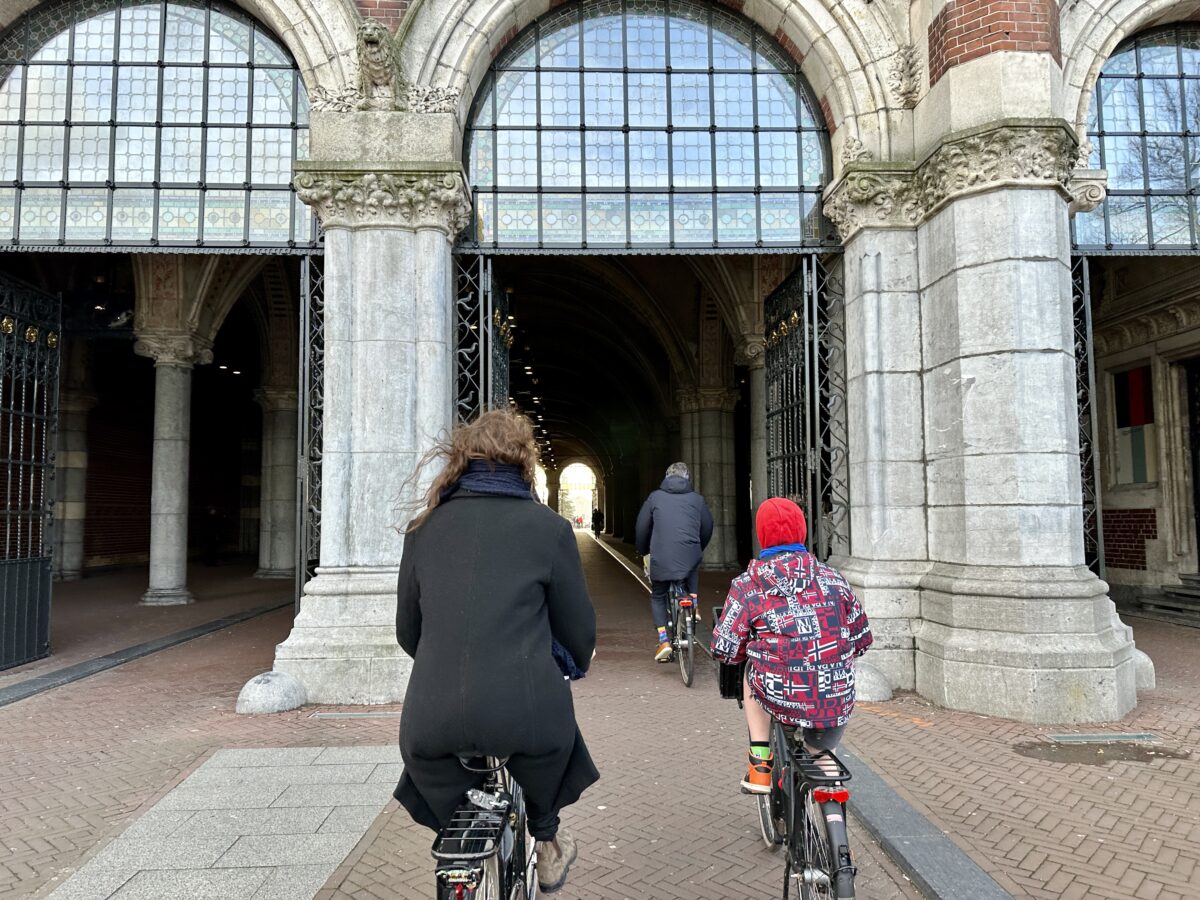
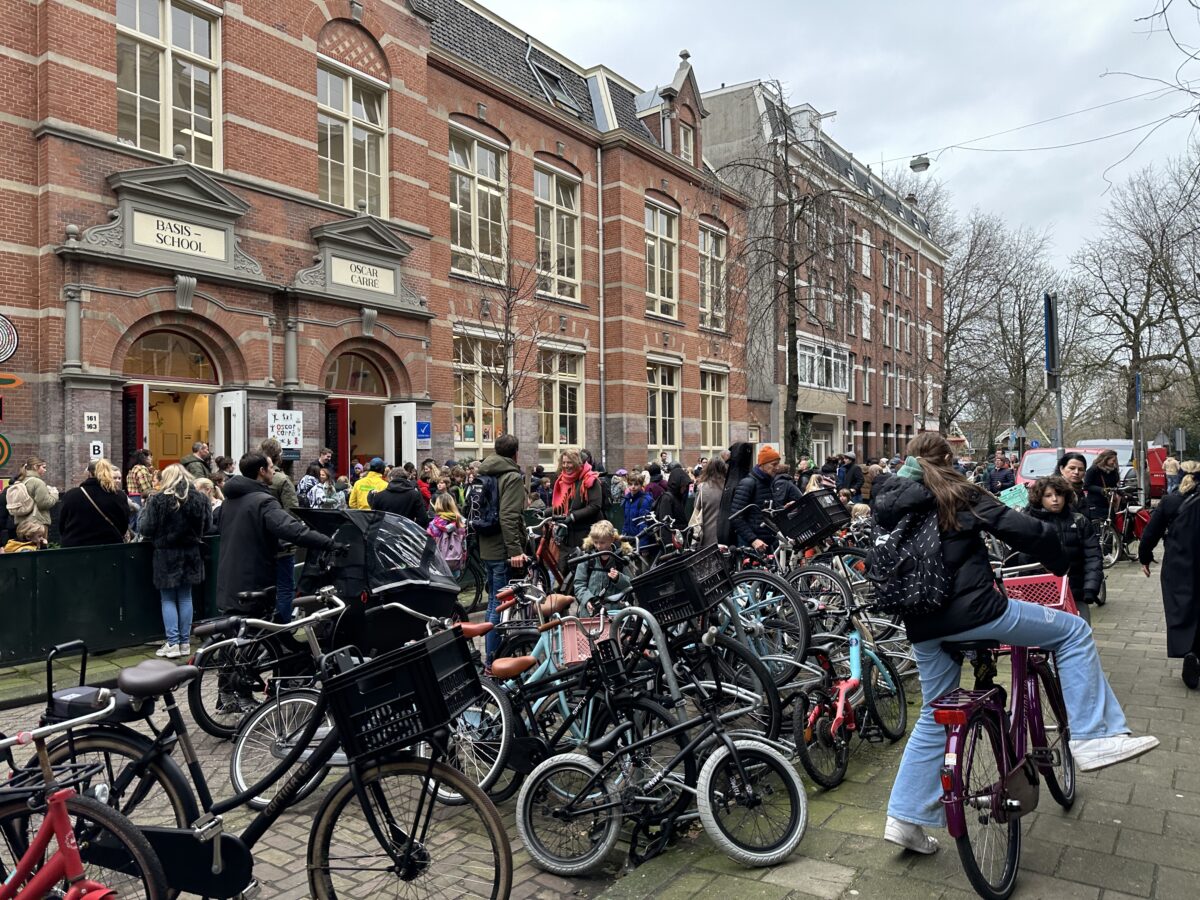

— This post is part of BikePortland Staff Writer Taylor Griggs’ trip through Europe. See previous dispatches here.
Ok, I think this is going to be my last story about The Netherlands for now. I really loved it, especially Amsterdam, as I’m sure is evident from my stories this week, but I think I’ve exhausted my capacity to write about this particular country for the time being. Plus, I’ve just arrived in Copenhagen, so I should probably try to stop thinking about Amsterdam for a while and pay attention to my surroundings here.
In the articles I’ve written from Utrecht and Amsterdam, I discussed several topics about the infrastructure (and also recounted my trouble with the law). But I realized I haven’t really written about my actual experience on a bike! So, here’s what I thought about the brass tacks of the Dutch bicycling experience.
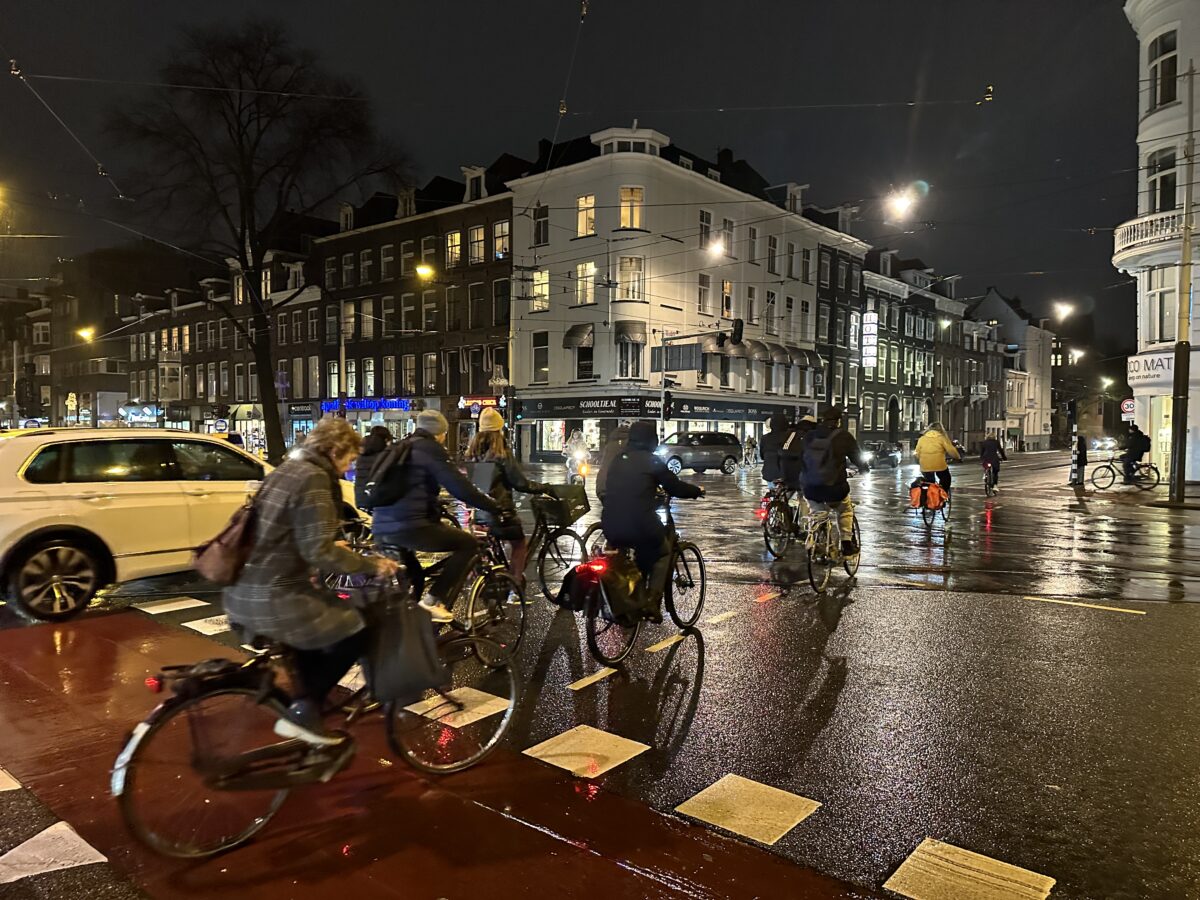
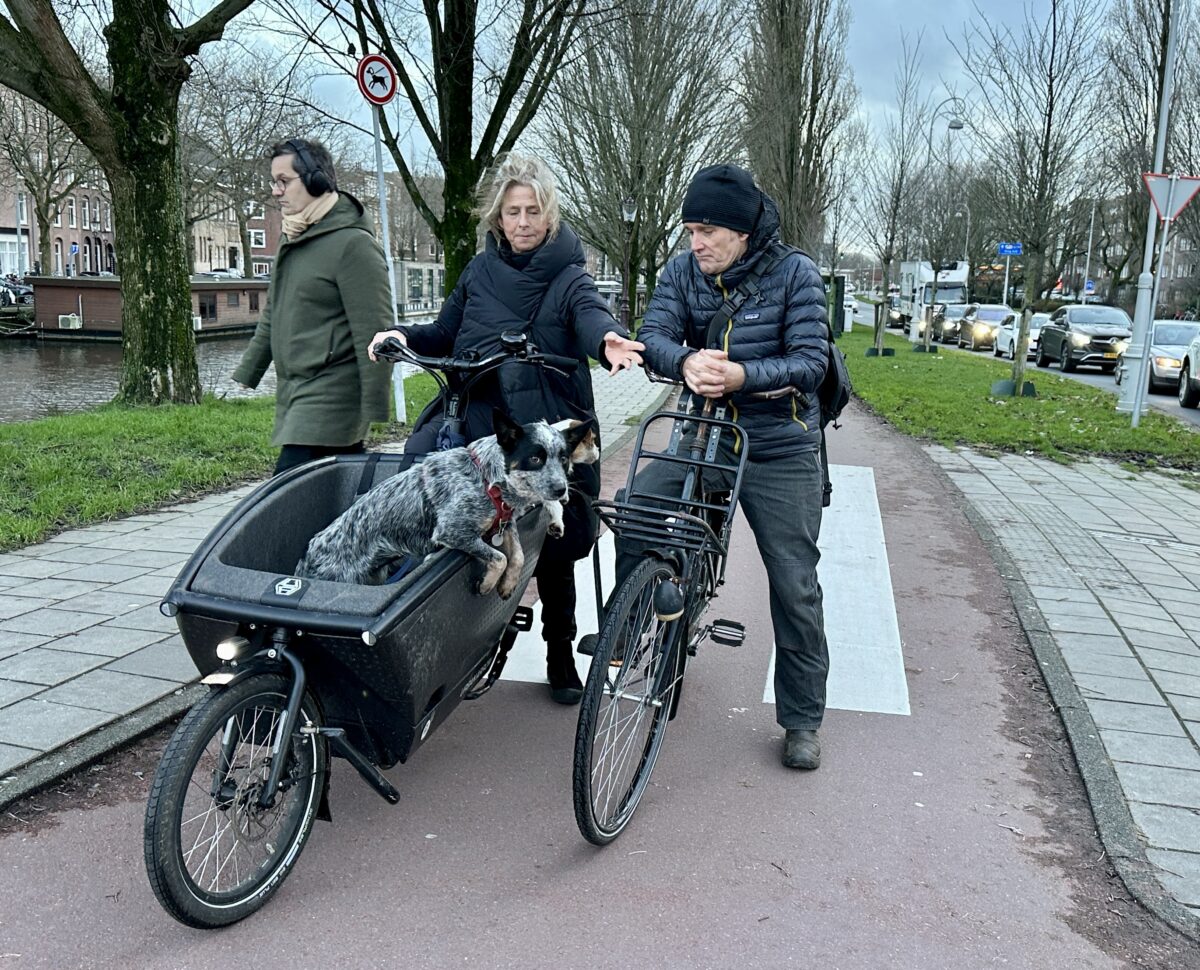

The bike itself
With the exception of my new electric bike, I’ve only ridden hybrid bikes with at least seven speeds since I stopped using training wheels. I like to maintain a relatively upright posture, but not so much that I feel like Miss Gulch in The Wizard of Oz. That’s sort of how I felt riding the Dutch-style bikes I rented in The Netherlands, and it took some getting used to — especially the braking system.
The rental shop offered bikes with hand brakes for a few more Euros, but I wanted to see if I could figure out the coaster brakes, so I opted for the cheaper one. At first, this was difficult, and along with attracting the attention of law enforcement, I also almost crashed into a parked car and several other things because I forgot how to stop. But once I got used to it, I realized I actually like this way of braking for traveling around flat areas.
I am prone to overusing my front brake while biking in Portland because I’m using my right hand to take photos, which is really not ideal. With coaster brakes, you can use your hands a lot more freely without risking flipping over the handlebars. Now, I don’t think this would work for me in places where you need to climb up and down hills any steeper than a canal bridge (yes, fixie people, I know!), but in Amsterdam it makes complete sense.
I think it’s kind of old-fashioned to sit completely upright on a bike (these bikes are often referred to as ‘omafiets,’ or ‘grandma bikes’), but the Dutch are able to pull it off with style. This posture definitely allows you to dress in more restrictive clothing while biking, so it’s perfect for people commuting to work.
Ultimately, this style of bike is perfect for flat Amsterdam, but there’s a reason people in Portland have their preferred alternatives. I don’t hate it, though!
In Utrecht a man who wanted to pass me on a bike path gently pushed me out of his way without saying a word… it was strange!
Locking up
Most Dutch bikes utilize a multi-prong locking system. The ring lock (a.k.a wheel lock) element enables you to lock just your back wheel, preventing people from quickly riding off with it when you just want to leave it alone for a little bit or can’t find anything to lock it to (a common problem with the volume of bikes in the country). For more security, you can use a chain bike lock that’s mounted to the bike to lock it to a rack.
Locals will tell you there’s a huge problem with bike theft in Amsterdam, but there are so many bikes in the city that if someone wants to steal one, they’re not going to take it if they can’t quickly ride away on it. And I must say that with the number of expensive Urban Arrows and VanMoofs I saw parked on the streets late at night, people must either feel confident it won’t get stolen or be willing to buy a new one if it does.
Ultimately, I’m probably just going to keep using my u-lock in Portland — I’m too paranoid to leave my bike untethered to an immovable object. But for some added security, maybe the ring lock method should get some traction in the U.S.?
The bike culture
I was a bit afraid I would stick out like a sore thumb in Europe with my American biking habits, but I think I managed to figure out how to roll with the crowd pretty easily. The only somewhat negative interaction I had, other than my conversation with the cops, was in Utrecht when a man who wanted to pass me on a bike path gently pushed me out of his way without saying a word. I didn’t fall over and it didn’t even seem mean-spirited, but it was strange!
Otherwise, people used their bells to communicate, which is something I think we ought to more fully embrace in the U.S. The only problem is that with all the car traffic in Portland, it can be hard to hear a bell ringing.
It was great to see people of all ages riding their bikes, looking relaxed instead of constantly stressed about safety. And I don’t think I saw a single soul wearing a helmet — it’s not necessary!
So, onwards I go on my journey. Thanks for reading my dispatches so far, and hopefully you don’t get tired of them, because I plan to keep them coming.




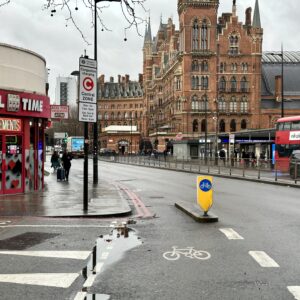

Thanks for reading.
BikePortland has served this community with independent community journalism since 2005. We rely on subscriptions from readers like you to survive. Your financial support is vital in keeping this valuable resource alive and well.
Please subscribe today to strengthen and expand our work.
Taylor, while you were in the Netherlands, did you see any disabled users? What accommodations did the Dutch have and/or ADA-type infrastructure?
It is common for people with mobility issues to use either a small car like the Canta, or a US-style mobility scooter, both of which are allowed to travel on the bike paths. This is an important note for anyone in the US encountering the argument that car infrastructure is necessary to maintain access for the disabled. It simply isn’t true, but people believe it because they haven’t experienced these kinds of mobility.
My (mostly uninformed) impression was that there generally is not as much accessibility in the Netherlands when it comes to actual building structures, however (e.g. no ramps, doorways may be narrow). In that regard, I think the US actually has a lot of potential to surpass many European countries when it comes to non-automobile disabled mobility.
It’s jarring how standard it is in Europe for businesses to have the bathroom in the basement, down a flight of narrow stairs. Even in newer buildings.
A bell with good resonance will always be easier to hear than “on your left” in my book. And while I’m loud enough to stop a car driver in their tracks with my “HEY!” – I don’t want to have to scream at fellow riders. I’ve found that ringing a bell for a reasonable distance gets a better “Okay, pass me” reaction from other riders than using my voice. The same goes for pedestrians. I’ve always found that a ding from a long enough distance gives them time to assess which way they’ll make way, whereas an “on your left” results in them moving left half the time, and with less time for them to react.
Squareman, you got it! There is a vast wasteland of bad and poorly designed bells…inadequate for safe and communicative riding.
As an example, Brompton’s included bell is similarly a waste…if only to make the lawyers and police/ vehicle inspectors happy to ‘tick a box’. I retrofit all our family’s Bromptons with a real bell.
It might have been expensive, but this is why I’m glad I bought a Spurcycle bell. I’m a fan of the long-distance loud ring to let people know ahead of time that a bike is coming up behind them. I’ve actually had some people walking on a MUP in Vancouver (Burnt Bridge Creek) yell after me “We like your bell!” I might have to get a 2nd one eventually for my 2nd bike.
As for cars… I’m genuinely considering getting an airhorn for those emergency situations.
Thanks for the sharing Taylor!
And I am so glad you got to pedal through the Rijksmuseum…as that ‘blew my [transport planner’s] mind’ the first time I did it in 1996. (Back before the internet and Google gave you a heads-up on planning a day’s route.)
Did you get to visit or meet up with the Fietsersbond folk?
As for coaster brakes…as you have now found out they are the best for city riding…and make it so much easier for riding in the rain with an umbrella (did you get to try?) or hold a Sony 8mm camera back in the day. You can find many a more modern Dutch city bike with a coaster brake AND handbrakes. Even a single speed oma fiets bike can be ridden through most of urban Portland, in my long experience.
As for being gently touched / guided by other riders…it is pretty common and expected in crowded situations…its more effective/ civilized than a voice command…it really goes back to the socialization and training of most Dutch cyclists …to their days as a child being cycle guided by their parents or riding as a giggling groups of teens and then training their own children.
Amazing. I can’t imagine that working here.
It’s very inappropriate.
Everyone with an expensive bike has bike insurance in Amsterdam (or the equivalent VanMoof subscription, which is worse and more expensive than insurance but quite popular), hence the apparent chillness about parking them on the street
So great to hear about your experience! I am looking forward to seeing what you think of Copenhagen, and how it compares to Amsterdam.
+1 for the frame lock/ring lock. Super easy to use, and adds another level of protection if you are using a u-lock or chain.
I’m not sure why anyone would say helmets are not necessary, life is just too unpredictable. My only crash/accident in recent years was on a totally empty street, no cars, bikes, or pedestrians. I felt something hit my right hand, then a second later a sharp pain on my wrist, I think a hornet got caught up my sleeve. Of course I took my hand off the grip for a second and either instinctively grabbed the front brake, or I hit that one pothole I always go around, and I was suddenly going over the bars in slow motion. My helmet now has big scratches on the left side that would have been my face/skull and I somehow only got a few bruised ribs and knees.
It’s your (younger than mine) body, so do what you want. I guess I just take my health and safety more seriously now that I’m a parent.
In many car accident situations a helmet would have helped the driver immensely. Yet we don’t make that a law or shame people who chose not to wear a helmet while driving. We don’t yell at drivers to wear a helmet when passing by.
I have a lot of experience riding a bicycle and I know when I want to wear a helmet. I own helmets, and I have spent a lot of money on them. But ffs people stop yelling at me to wear when I ride to to the grocery story for the billionth time. If you hit me with your car, the helmet is probably not going to do much. Helmet manufacturers and government regulatory agencies don’t test for the effective-ness of a bicycle helmet in a car collision because it obviously isn’t going to help.
But when they pull my mangled corpse from underneath of a car you know media outlets are going to state if I was wearing a helmet or not in the first few sentences of the report.
It sounds like the bike riding population of Amsterdam disagrees.
Maybe because many have coaster brakes? When they get stung by hornets, they don’t have to worry about instinctively grabbing for their front brakes.
“Life is just too unpredictable”, can also be interpreted the other way. There are lots of other unpredictable reasons for dying that you can’t see coming nor prevent.
So for each preventative measure there is a point where you perceive the risk reduction no longer worth the effort. A lot of this is psychology, cultural and personal. Having been to both US and Canada there I would very likely wear a helmet when cycling, but not here in the Netherlands. Just because the bigger, faster traffic that comes way closer feels much more dangerous.
So to get an idea about what helmets could reduce. The estimate is that if every cyclist in the Netherlands would start wearing a bike it would reduce the deaths by about 85 people per year, of which 45-50 over 70. On a total of about 200 cycle deaths a year that is quite significant. However, compared to a total of about 150k deaths that is quite insignificant.
A lot of those are elderly people dying, so lets restrict to a more dangerous age for cycling and look at the group of 20-30 year old. That group is about 2M people, of which about 700 people die in a year*, about 300 of diseases and 10 when cycling. So my interpretation is that a helmet would prevent an already very very unlikely cause of death, one that is far less likely than a lot of other causes.
*) I used the statistics of 2019 to remove the effects of the Covid pandemic.
Doesn’t everyone gently push others out of the way when they’re walking quickly along a sidewalk? Seems very normal tbh ¯\_(ツ)_/¯
No.
And I would regard someone who “pushes” people out of the way simply because they are in a hurry as being very rude.
Sorry, touching strangers on a bicycle doesn’t sound appropriate anywhere.
Frank – I agree with your understanding and reaction to the word “push” used on the face of it for this discussion.
BUT the action Taylor is referring to – and one that I have experienced on the bike ways of the Netherlands many times – is more akin to a lighter touch so that a cyclist does not collide hard with another. If you ever get the chance to see it its more organic vs vehicular – like ants in a column flow.
As someone who’s worked in a physical rehabilitation hospital for 20 years, I mainly wear a FF helmet. If you don’t survive, you won’t miss the potential for surviving a car collision. For the same reason I wear one riding motorcycles. As it is, I have to brake to stay below 25-30mph in my home terrain, before I can access flatter terrain in my wider community.
I love bike bells, but too many times calling “on your left” to pedestrians or cyclists who are plugged into their ear buds, so bells are not reliable warning devices anymore, sadly. I’m even more appreciative of the practicality of an air horn in traffic situations, along with being assured other cyclists or peds know I’m overtaking; they can be lightly, briefly sounded without being harsh or aggressive.